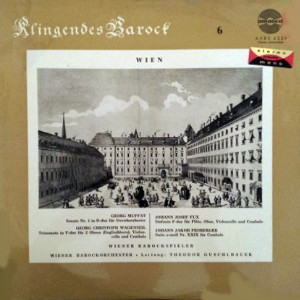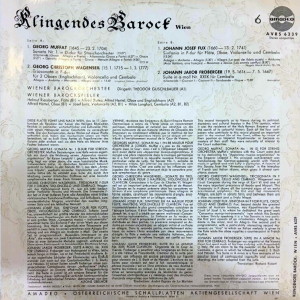 |
1 LP -
Amadeo AVRS 6339
|
 |
|
| WIEN -
Klingendes Barock - 6 |
|
|
|
|
|
|
|
| Georg Muffat
(1645 - 23.2.1704) |
|
|
|
Sonata Nr. 1 in
D-dur für Streichorchester
|
|
13' 07" |
A1 |
| - Allemanda
(Grave - Allegro e Presto) ·
Allemanda (Grave e Forte) |
6' 27" |
|
|
| -
Grave |
2' 27" |
|
|
| -
Gavotta (Allegro e Forte) · Grave
· Menuet (Allegro e Forte) |
4' 06" |
|
|
|
|
|
|
Georg Christoph
Wagenseil (15.1.1715 - 1.3.1777)
|
|
|
|
Triosonata in
F-dur für 2 Oboen (Englishhorn),
Violoncello und Cembalo
|
|
13' 40" |
A2 |
| -
Allegro · Andante · Menuetto ·
Allegro assai |
|
|
|
|
|
|
|
Johann Joseph
Fux (1660 - 13.2.1741)
|
|
|
|
Sinfonia in F-dur
für Flöte, Oboe, Violoncello und
Cembalo
|
|
13' 34" |
B1 |
| - Adagio ·
Andante · Allegro |
5' 30" |
|
|
| -
Allegro (La joye des fidels
sujets) · Andante (Aria Italiana,
aire français) · Maestoso e
dezioso (Les enemis confus) |
8' 00" |
|
|
|
|
|
|
Johann Jakob Froberger
(19.5.1616 - 7.5.1667)
|
|
|
|
Suite
in a-moll Nr. XXIX für Cembalo
|
|
9' 58" |
B2 |
| -
Allemande · Courante I · Courante
II · Sarabande · Gigue |
|
|
|
|
|
|
|
WIENER
BAROCKORCHESTER / Theodor
Guschlbauer, Dirigent
(Muffat)
|
|
WIENER
BAROCKSPIELER
|
|
| - Helmut
Riessberger, Flöte
(Fux) |
|
| - Alfred Dutka,
Alfred Hertel, Oboe und
Englishhorn (Wagenseil) |
|
| - Alfred Hertel, Oboe
(Fux) |
|
| - Josef Luitz, Violoncello
(Wagenseil, Fux) |
|
| - Hilde Langfort, Cembalo
(Wagenseil, Fux, Froberger) |
|
|
|
|
|
Luogo
e data di registrazione |
|
Baumgarten,
Vienna (Austria) - settembre 1964
|
|
|
Registrazione:
live / studio |
|
studio |
|
|
Edizione LP |
|
AMADEO
- AVRS 6339 - (1 lp) - durata 50'
19" - (p) 1966 - Analogico |
|
|
Altre edizioni
LP
|
|
MUSICAL
HERITAGE SOCIETY - MHS 601 - (1
lp)
|
|
|
Prima Edizione
CD |
|
- |
|
|
Note |
|
Stereo
compatibile
|
|
|
|
|
This record
transports us to
Vienna during its
political,
economic and
cultural heuday in
the 17th century,
when it was the
residence of the Holy
Roman Emperor
and at the
zenith of its
colourful
history. Each of
the four
composers who
contribute to
this record
played an
important part
in the musical
life of the
Court,
either by
virtue
of their
position as
Imperial
Kapellmeister
or because as
masters of
their craft
they were
naturally of
interest to
the Court
authorities.
GEORG
MUFFAT: SONATA
No 1 in D FOR
STRING
ORCHESTRA.
Muffat's
relations with
the Court were
due to his
dedicating his
"Apparatus
musico-organisticus"
to the Emperor
LEopold I. His
principal
achievement
was
familiarising
the
German-speaking
world with
French music
in general and
with Lully in
particular. A
feature of
this Sonata
from the
"Armonico
tributo" is
the interplay
of French and
Italian idioms,
which gives it
almost
symphonic
stature.
GEORG
CHRISTOPH
WAGENSEIL:
TRIOSONATA IN
F FOR 2
VIOLINS, CELLO
AND CEMBALO.
Wagenseil was
Court Composer
during the
reign of Karl
VI and one of
the more
important
precursors of
Haydn aand
Mozart. This
Triosonata in
F shows all
the outward
signs of an
early
pre.classical
symphony: the
first and last
movements,
Allegro, are
both in sonata
form, and
between them
are a slow
movement and a
lively Minuet.
JOHANN
JOSEF FUX:
SINFONIA IN F
FR FLUTE,
OBOE, CELLO
AND CEMBALO.
Fux, beyond
doubt the
greatest
master of
Austrian
baroque, was
Kapellmeister
at the Court
of Jesef I,
tho whom
he dedicated
the great work
"Concentus
musico-instrumentalis"
from which
this Sonata is
taken.
Strictly
speaking it is
a Trio Sonata
in two parts:
the first part
consists of an
introductory
adagio, an
Andante in the
minor, and an
Allegro: the
second part is
programmatic,
with a
particularly
interesting
second
movement, an
"Aria" in
which an
Italian melody
is given to
the flute
while the oboe
supplies a
counterpoint
in French
rhythm.
JOHANN
JAKOB
FROBERGER:
SUITE IN A
MINOR No. XXIX
FOR CEMBALO.
Froberger was
organist at
the Vienna
Court but
spent much of
his time
studying with
Frescobaldi in
Italy. He can
claim to be
the inventor
of the Suite
for Cembalo, a
genre in which
he influenced
even J. S.
Bach and Händel.
This Suite in
A minor is a
fine example
of his
peculiar blend
of
contrapuntal
ingenuity and
sonorous
chording, the
latter adapted
from the lute.
Alfons
Übelhör
(Translation:
Richard
Richett)
|
|

